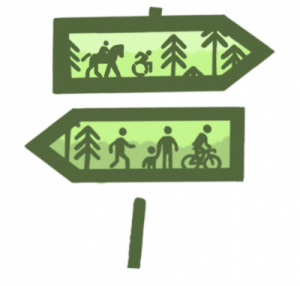
Discover the exciting expansion of the Trails and Active Living Program by UConn Extension, which aims to increase accessibility to the great outdoors. With over 2,000 miles of multi-use trails in Connecticut’s state parks and forests, the UConn CT Trails Program is dedicated to ensuring that everyone, regardless of their experience level, can experience the beauty and magic of these greenways. The program, consisting of the Connecticut Trail Census, Connecticut Trail Finder, and People Active on Trails for Health and Sustainability (PATHS), has recently been awarded two major grants to expand its reach and provide valuable data on trail usage. Through innovative data collection methods, a user-friendly website, and community engagement, the program aims to promote the benefits of trail use and elevate Connecticut’s trails to a must-visit destination.

This image is property of e9i3r2v2.stackpathcdn.com.
CT Trails Program and its Expansion Efforts
Overview of the CT Trails Program
The CT Trails Program, also known as CT Trails, is an initiative led by UConn Extension and the UConn College of Agriculture, Health and Natural Resources (CAHNR) with the aim of expanding access to Connecticut’s extensive trail network. The program has recently received two major grants from the state Department of Energy and Environmental Protection (DEEP) to further its work in trail education, outreach, and research. CT Trails encompasses three projects: the Connecticut Trail Census, Connecticut Trail Finder, and People Active on Trails for Health and Sustainability (PATHS).
Mission and Goals of the CT Trails Program
The mission of the CT Trails Program is to ensure that as many people as possible can experience the beauty and benefits of Connecticut’s trails. The program aims to educate the public about trail resources, facilitate trail use, and collect data on trail usage for research and planning purposes. The goals of the program include increasing awareness of trails, promoting physical and mental health through outdoor recreation, enhancing community interactions, and contributing to environmental education and conservation efforts.
Importance of Expanding Access to the Outdoors
Expanding access to the outdoors is crucial for the well-being of individuals and communities. Research has shown that spending time in nature has numerous physical and mental health benefits, including reduced stress, improved mood, increased physical activity, and enhanced cognitive function. By providing opportunities for people to explore Connecticut’s trails, the CT Trails Program is playing a vital role in promoting healthy and sustainable lifestyles.
Connecticut Trail Census
Role and Purpose of the Connecticut Trail Census
The Connecticut Trail Census is a project under the CT Trails Program that aims to collect data on trail usage throughout the state. By using innovative data collection methods such as infrared sensors, the Trail Census provides valuable information on when and how trails are used. This data helps land use officials understand the role of trails in people’s lives and supports trail development and maintenance efforts.
Data Collection Methods
The Connecticut Trail Census employs various data collection methods to gather information on trail usage. Infrared sensors installed along the trails record the number of trail users, and this data is analyzed to identify patterns and trends in trail usage. The Trail Census also uses surveys, such as a recent pilot program with QR codes, to supplement the data collected by the sensors. These data collection methods provide important insights into trail usage and help inform decision-making processes.
Trends and Insights from the Connecticut Trail Census
Since its inception in 2017, the Connecticut Trail Census has revealed several interesting trends in trail usage. For example, there was a significant increase in outdoor use during the height of the COVID-19 pandemic in 2020. While trail usage has decreased from the peak of the pandemic, it remains higher than pre-COVID times. The data collected by the Trail Census allows researchers and policymakers to understand the changing patterns of trail usage over time and adapt their strategies accordingly.
Plans for Future Expansion
With the new grant funding, the Connecticut Trail Census plans to expand its efforts. One important development will be the creation of an easy-to-navigate web dashboard that provides access to the census data. This will allow stakeholders, including urban planners and policymakers, to access and utilize the data more effectively. Additionally, the Trail Census will continue exploring alternative data collection methods to improve the accuracy and comprehensiveness of the trail usage data.

This image is property of e9i3r2v2.stackpathcdn.com.
Connecticut Trail Finder
Features and Functionality of the Connecticut Trail Finder
The Connecticut Trail Finder is a mobile-friendly website that serves as a comprehensive guide to Connecticut’s trail network. It allows users to search for trails based on their preferences, such as distance, difficulty level, accessibility, and amenities available. Unlike crowd-sourced hiking apps, every entry in the Trail Finder is reviewed by trails managers to ensure accuracy and authorized access information.
Trail Cataloguing and Review Process
To provide accurate and reliable information, the Connecticut Trail Finder relies on a rigorous cataloguing and review process. Trails managers review each entry before it is included in the Trail Finder to verify its authenticity and update information. This ensures that trail users have access to up-to-date and reliable information when planning their outdoor adventures.
Upcoming Enhancements to the Connecticut Trail Finder
The Connecticut Trail Finder has plans for future enhancements to further improve the user experience. One upcoming feature is an expanded network of trails, allowing users to discover even more outdoor destinations across the state. Additionally, the Trail Finder will incorporate a “trailside services” module, which will provide information on nearby amenities such as ice cream shops, coffee shops, and public transit options. Users will also have the opportunity to collect badges showcasing the trails they have visited, adding a fun and interactive element to their trail experiences.
People Active on Trails for Health and Sustainability (PATHS)
Overview of PATHS Program and its Objectives
People Active on Trails for Health and Sustainability (PATHS) is a program that promotes the benefits of trail use and outdoor physical activity. PATHS, which is part of the CT Trails Program, brings together educators, faculty, and staff from various disciplines to engage in community outreach and education. The program aims to address public health concerns, promote community development, and foster sustainable practices through trail use.
Community Outreach and Engagement Efforts
PATHS implements a range of community outreach and engagement efforts to encourage trail use and promote the benefits of outdoor physical activity. These efforts include hosting pop-up outdoor recreation days, networking events for community members and leaders, and the distribution of educational materials that highlight the importance of trail use. By actively engaging with communities, PATHS aims to understand and address barriers to outdoor physical activity and recreation, and promote community health and well-being.
Integration of Research and Grant Funding
While PATHS initially operated as an Extension-led project, it has now become part of the CT Trails Program and benefits from the program’s research capabilities and grant funding. This integration allows PATHS to leverage the research conducted at UConn and apply it to real-world scenarios, benefiting landowners, policymakers, and local decision-makers. By integrating research and grant funding, PATHS ensures that its efforts are evidence-based and have a real impact on local communities.

This image is property of e9i3r2v2.stackpathcdn.com.
Importance of Accessible Trails
Promoting Physical and Mental Health
Accessible trails play a crucial role in promoting physical and mental health. Studies have shown that spending time in nature and engaging in outdoor activities can improve physical fitness, reduce the risk of chronic diseases, and alleviate mental health issues such as stress, anxiety, and depression. By expanding access to trails, the CT Trails Program is providing opportunities for individuals to engage in outdoor recreation and improve their overall well-being.
Enhancing Community Interactions and Connections
Trails serve as community gathering spaces and help foster social interactions and connections. Accessible trails provide opportunities for people from diverse backgrounds to come together, engage in outdoor activities, and build relationships. By expanding access to trails, the CT Trails Program is promoting community cohesion and strengthening the social fabric of Connecticut’s towns and cities.
Environmental Education and Conservation Efforts
Accessible trails offer opportunities for environmental education and conservation. By engaging with nature firsthand, individuals can learn about local ecosystems, wildlife, and conservation practices. Trails can serve as platforms for environmental education programs and initiatives, encouraging stewardship of the natural environment. Through its focus on expanding access to trails, the CT Trails Program is contributing to environmental education and promoting conservation efforts.
Impacts of CT Trails Program on Connecticut
Increased Awareness and Utilization of Local Trails
The CT Trails Program has significantly increased awareness and utilization of Connecticut’s local trails. Through its outreach and educational efforts, the program has been successful in highlighting the abundance of trails available in the state. As a result, more people are discovering and exploring these trails, leading to increased usage and appreciation of Connecticut’s natural resources.
Economic Benefits for Local Communities
Accessible trails have the potential to provide significant economic benefits to local communities. Trails attract visitors, who often spend money on accommodations, food, and other goods and services, thereby stimulating local economies. By expanding access to trails, the CT Trails Program is indirectly supporting local businesses and contributing to the economic development of communities across the state.
Partnerships and Collaborations for Trail Development
The CT Trails Program has fostered partnerships and collaborations for trail development. By bringing together various stakeholders, including government agencies, nonprofit organizations, and local communities, the program has created a unified approach to trail development and maintenance. These partnerships ensure that trail projects are well-planned, properly funded, and sustainable in the long term.

This image is property of e9i3r2v2.stackpathcdn.com.
Upcoming Events and Symposium
Overview of the Connecticut Trail Symposium
The Connecticut Trail Symposium is an annual event hosted by CT Trails to bring together trail enthusiasts, professionals, and stakeholders. The symposium serves as a platform for sharing knowledge and experiences related to trail development, management, and promotion. It provides an opportunity for networking, learning, and fostering collaboration among trail advocates and professionals.
Keynote Address and Speakers
The upcoming Connecticut Trail Symposium will feature a keynote address by Joseph Dickerson, the Senior Advisor for Outdoor Equity at CT DEEP. The symposium will also include presentations and discussions by industry experts, researchers, and trail enthusiasts. The speakers will cover a wide range of topics, including trail design, sustainable trail development, community engagement, and the benefits of outdoor recreation.
Activities and Registration Details
In addition to the symposium, participants can enjoy various activities leading up to the event. These activities may include film screenings, historical and recreational attractions, and guided hikes. The symposium provides an excellent opportunity for individuals and organizations interested in trails to learn, network, and engage with like-minded individuals. Registration details and additional information can be found on the CT Trails website.
CT Trails Program and Sustainable Development
Integration with Urban Planning and Resource Management
The CT Trails Program recognizes the importance of integrating trail development with urban planning and resource management. By incorporating trails into urban planning initiatives, the program aims to create more sustainable and livable communities. Well-designed and accessible trails can provide alternative transportation options, promote active lifestyles, and enhance the natural and cultural assets of cities and towns.
Data-Driven Decision Making for Trail Development
The CT Trails Program emphasizes the use of data-driven decision making for trail development. Through initiatives like the Connecticut Trail Census, the program collects valuable data on trail usage and user preferences. This data enables informed decision making when it comes to planning new trails, improving existing trails, and allocating resources for trail development and maintenance.
Long-Term Goals for Sustainability and Conservation
Sustainability and conservation are at the forefront of the CT Trails Program’s long-term goals. The program aims to ensure that trail development initiatives are aligned with principles of environmental sustainability, such as minimizing environmental impact, preserving natural habitats, and promoting responsible trail use. By prioritizing sustainability and conservation, the program aims to protect Connecticut’s natural resources for future generations to enjoy.

This image is property of e9i3r2v2.stackpathcdn.com.
Future Expansion of CT Trails Program
Plans for Statewide Trail Coverage
The CT Trails Program has ambitious plans for statewide trail coverage. The program aims to catalog and promote trails in every corner of Connecticut, ensuring that all residents have access to nearby outdoor recreational opportunities. By achieving statewide trail coverage, the program hopes to increase awareness of trails, improve trail connectivity, and enable people across the state to explore and appreciate the natural beauty of Connecticut.
Integration of Emerging Technologies
The CT Trails Program recognizes the potential of emerging technologies to enhance trail experiences and accessibility. The program aims to integrate technologies such as mobile applications, virtual reality, and augmented reality into its initiatives. These technologies can provide interactive trail maps, virtual trail experiences, and real-time information on trail conditions, further improving the user experience and encouraging more people to explore Connecticut’s trails.
Collaborations with Other Trail Programs
The CT Trails Program actively seeks collaborations with other trail programs and initiatives. By partnering with organizations that share similar goals, the program can leverage resources, expertise, and networks to further expand and enhance its trail development efforts. Collaborations with other trail programs foster information sharing, best practices exchange, and coordinated advocacy for trails, ultimately benefiting trail users and communities across Connecticut.
Conclusion
The CT Trails Program is making significant strides in expanding access to Connecticut’s trails. Through initiatives like the Connecticut Trail Census, Connecticut Trail Finder, and PATHS, the program is promoting trail usage, collecting valuable data, and engaging communities in outdoor recreation and environmental education. The program’s efforts have resulted in increased awareness and utilization of local trails, economic benefits for communities, and partnerships for trail development. With future expansion plans and a focus on sustainable development, the CT Trails Program is poised to continue its positive impact on individuals, communities, and the environment in Connecticut. The importance of continued trail expansion and accessibility cannot be overstated, as it contributes to the physical and mental well-being of individuals, strengthens communities, and promotes environmental stewardship. By prioritizing trail development and accessibility, the CT Trails Program is creating a legacy of sustainable outdoor recreation for current and future generations to enjoy.






